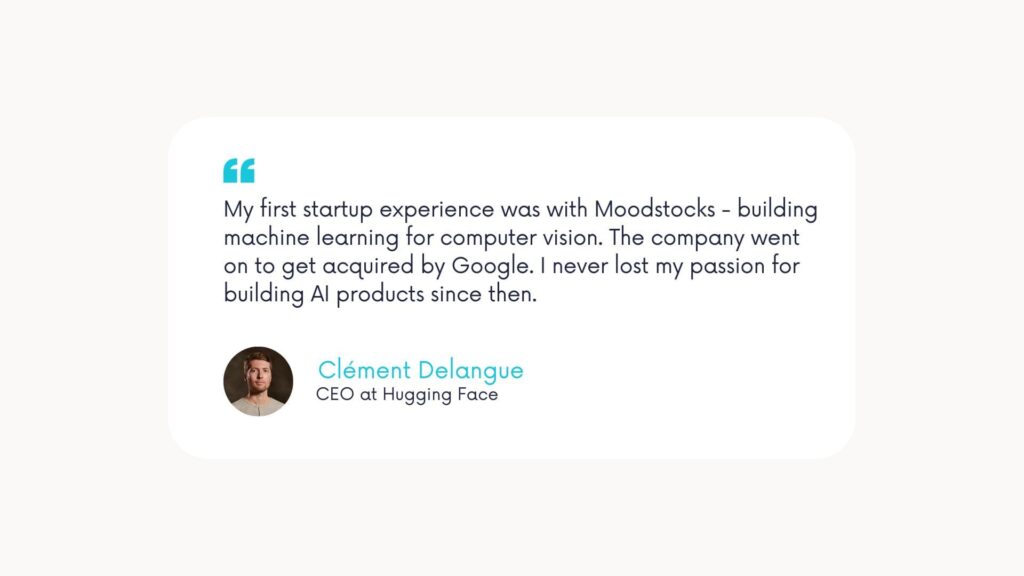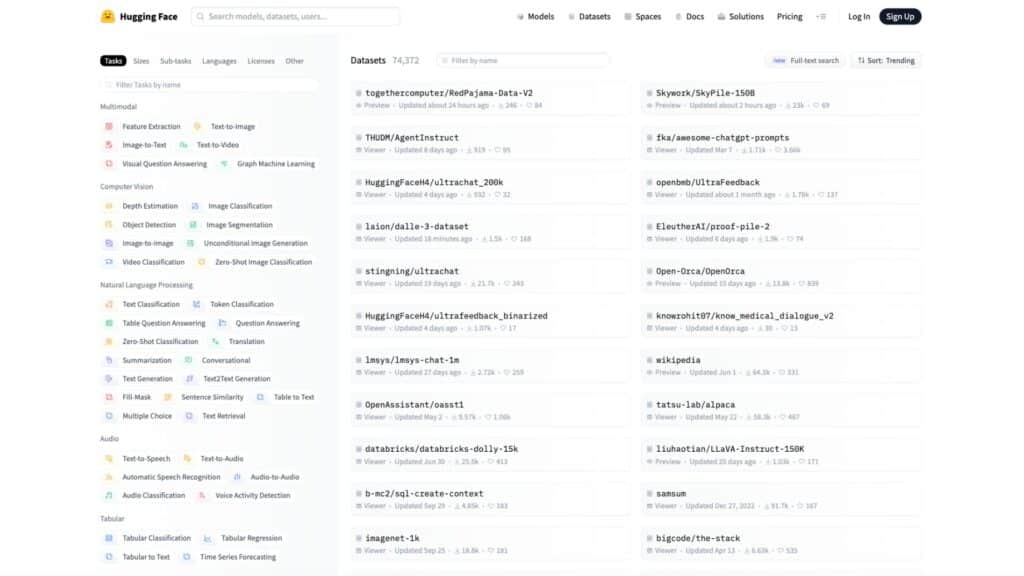Imagine if everyone had the power to create, collaborate on, and share artificial intelligence models as easily as sharing code on GitHub. That’s the kind of magic Clément Delangue and his company, Hugging Face, have been conjuring up in the world of artificial intelligence and language for already as much as 15 years by now.
Prepare yourself for an interesting journey where we’re going to talk about the inspirational success story of the CEO and co-founder of Hugging Face, a startup that develops artificial intelligence software and provides hosting services for other businesses valued at $4.5 billion – Clement Delaunge. We will speak about his background, the success story behind Hugging Face, the challenges he’s faced, and the ways he’s tackled them.
Background & Education
If you are familiar with Hugging Face, then you might have asked yourself: who is the CEO of Hugging Face? And you would probably be very interested to know his background.
Meet Clement Delangue. He grew up in the quaint town of La Bassée in northern France. His early years were marked by the ordinary rhythms of small-town life. However, at the age of 12, everything changed when he got his first computer (and we know that almost every success story starts like this). Little did he know that this key moment would set the stage for his remarkable path to success.
Due to his entrepreneurial spirit, he started to import ATVs and bikes from China, which he used to stock in his father’s garden equipment shop. His sales skills were so good that eBay took notice of him. Thus, when he started college at ESCP Business School in Paris, EBay decided to offer him an internship opportunity. So, by the time Clem reached 17, he had already achieved an impressive accomplishment, becoming one of the most prominent French sellers on eBay.
“As I was amongst the first professional sellers on the platform at the age of 17, I joined the EU Enterprise Team and the wider eBay Team to turn this strategy into business results both in France and in the UK,” says Clement in his LinkedIn profile.
During a trade show, Clement met one of the founders of Moodstocks, a small startup. He was amazed that despite being small, yet Moodstocks achieved as much as Google, a much larger company. This startup’s success left a strong impression on Clement, so he even decided to pass up on eBay’s offer to extend his internship so he could dedicate his free time to working with Moodstocks.
Meanwhile, in 2011-2012, he successfully finished the “Introduction to Computer Science” and “Programming Methodology” courses at Stanford University through the Stanford Engineering Everywhere program. Interestingly, after graduating in 2012 from ESCP Business School, he turned down a job offer from Google and started his entrepreneurial path.
However, his initial attempt to create a collaborative note-taking app didn’t really succeed. Yet, a significant turning point came in 2016 when he met Julien Chaumond, another entrepreneur. They both shared a passion for open technology and began discussing the idea of starting a company together. Then a third (future) co-founder joined their team, Thomas Wolf, who happened to be a college friend of Julien Chaumond. Thomas had an impressive academic background, holding a Ph.D. in physics and having authored research papers in machine learning. Together, they brainstormed and settled on “open-domain conversational AI.” In simpler terms, they aimed to create a chatbot that could comprehend and engage in conversations on various topics.

Thus, their collaboration led to the creation of the well-known nowadays Hugging Face, a chatbot powered by natural language processing (NLP).
What is the history of Hugging Face?
As previously pointed out, Clement Delaunge, Julien Chaumond, and Thomas Wolf shared a common vision and love to open sources. So together, they funded Hugging Face. But before we delve into the history of Hugging Face, let’s find out why is Hugging Face named so?
“When we started Hugging Face, we joked with Michael, founders Julia, and Thomas. We said we wanted to be the first company to go public with an emoji instead of the typical three-letter ticker. And the choice was the hugging face emoji – it was our favorite emoji. So, we thought, “Okay, let’s do that.” We initially considered it for just a few weeks. Then the community began to use it everywhere, you know, on social media. So, we thought, “Oh, maybe we’re going to keep it.” says Clem Delaunge in the interview with Harry Stebbings.
Now let’s delve a little bit into the history of Hugging Face. In the company’s early days, its mission was twofold: tackling scientific challenges while keeping things fun. They initially created an AI Tamagotchi, like a chatbot meets GPT, with a strong emphasis on entertainment. This was a time when digital assistants like Siri and Alexa were primarily focused on productivity, but they believed the potential for AI was much broader.
Their whole journey began thanks to Thomas Wolf, one of the co-founders. He started by porting Google’s “Birds” to PyTorch one weekend. When he released it on GitHub, it gained a surprising amount of attention, propelling them into the world of AI. They expanded the repository with more models, and a thriving community formed around it, making it one of the most popular GitHub repositories for AI. This pivotal moment transitioned them from their initial idea to where they are now.
They poured their energy into this concept for nearly 3 years, securing pre-seed and seed investments. Users embraced the idea, engaging in billions of messages. But their journey didn’t stop there, of course. They pivoted to become what they are today – a thriving open AI platform, constantly pushing the boundaries of AI’s possibilities.

The Hugging Face nowadays
Hugging Face has evolved into the most widely used open platform for AI. Think of it like a GitHub for machine learning artifacts, where people host, collaborate on, and share AI models. With over a million open-source repositories, you’ll find well-known models like Stable Diffusion, T5, BERT, Bloom, and Whisper. The platform also offers access to over 20,000 open datasets and hosts more than 100,000 demos. Notably, more than 15,000 companies rely on Hugging Face to integrate AI into their features, products, and workflows.
Hugging Face has 2 main directions they are currently pursuing. First, they observe a shift in AI from being a niche technique to becoming the default approach for building technology. This entails expanding beyond text, which is already heavily used on their platform, to include text-to-image and venturing into various domains. For instance, they’re introducing open-source text-to-video models and exploring time series models for financial predictions. Hugging Face aims to cater to a wide range of AI use cases.

The second focus is on democratizing AI. While historically, their platform was designed for machine learning engineers, they’re now making it more accessible to a broader audience, including software engineers, product managers, and infrastructure engineers. Their goal is to reduce the barriers to entry so that every company or team can use open source to train their own models.
“We’re also trying to build a future that we’re excited about. I think a lot of people are kind of scared about AI right now and the potential and the risks associated with it. The way we think about things, if you can build a future where everyone can understand AI and build AI, you remove many of these risks because you involve more people. So, you reduce, for example, the probability of very biased systems. You give the tools for regulators to put safeguards in place, and you give companies capabilities to align the systems. We sometimes say that our mission is to democratize good machine learning, and we’re working really hard on that because we think it’s important for the world.” shares Clement Delaunge about the values and mission of Hugging Face.
While competitors, such as Anthropic, led by Daniela Amodei and Dario Amodei, adopt a “constitutional AI” approach, essentially forming a set of rules as they train models to govern their actions, people at Hugging Face are taking a different path. They recognize that controlling, improving, and aligning an AI system is nearly impossible if you don’t fully comprehend it. Therefore, Hugging Face’s core emphasis lies in promoting transparency. They’re fully committed to shedding light on the inner workings of these systems, unveiling the data they’re trained on, addressing their limitations, and confronting any inherent biases. Clement believes that increased transparency in these areas is key to creating a more stable and reliable system, and that’s where their primary focus lies.
Summary
Clément Delangue’s journey of success is fueled by a passion for open source and a commitment to democratizing AI. Let’s look at Hugging Face’s evolution from a fun AI Tamagotchi to the most widely used open platform for AI models, which truly highlights the growth of Clément Delangue’s visionary mindset.
His mission to empower more people to understand, build, and use AI while promoting ethics, transparency, and accountability sets Clement as a compelling example for future innovators. He is definitely an innovator with great potential to make the world a better place with the help of technology.










